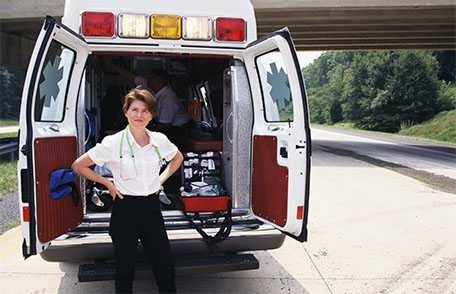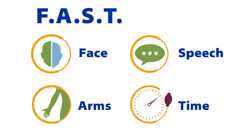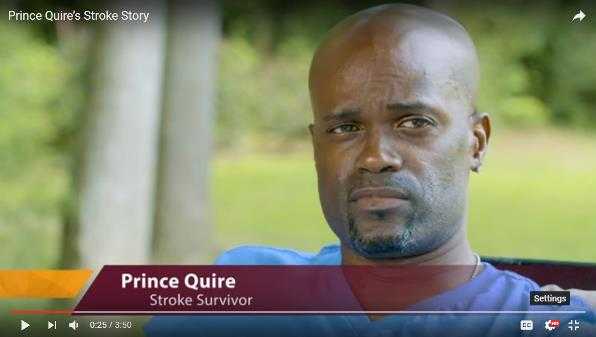How to Survive a Stroke
 When a stroke happens, every second counts. The best chance for a full recovery from stroke comes from recognizing stroke symptoms, calling 9-1-1, and getting treatment as quickly as possible. For National Stroke Awareness Month, learn the symptoms of stroke and why calling 9-1-1 can help you or a loved one survive a stroke.
When a stroke happens, every second counts. The best chance for a full recovery from stroke comes from recognizing stroke symptoms, calling 9-1-1, and getting treatment as quickly as possible. For National Stroke Awareness Month, learn the symptoms of stroke and why calling 9-1-1 can help you or a loved one survive a stroke.
Every year in the United States, nearly 800,000 people have a stroke.1 Stroke is the fifth leading cause of death and a major cause of disability in adults.1 Yet 1 in 3 stroke patients never takes advantage of a key resource that would improve their odds of recovering from stroke: emergency medical services (EMS).
Step 1: Know the Signs

Acting F.A.S.T. can save a lifelong disability after a stroke.
Don’t be caught off guard. Know the signs of stroke and make a commitment to yourself and your loved ones to call 9-1-1 right away if you notice any of the signs of stroke.
Stroke symptoms include:4
- Sudden numbness or weakness, especially if only on one side of the body.
- Sudden painful headache.
- Sudden dizziness, lack of balance, or trouble walking or speaking.
- Sudden confusion, difficulty talking or understanding.
- Sudden trouble seeing in one or both eyes.
If you think someone else is having a stroke, act F.A.S.T. with this simple test:
- F—Face: Ask the person to smile. Does one side of the face droop?
- A—Arms: Ask the person to raise both arms. Does one arm drift downward?
- S—Speech: Ask the person to repeat a simple phrase. Is the speech slurred or strange?
- T—Time: If you see any of these signs, call 9-1-1 right away.
Step 2: Call 9-1-1 to Have EMS Take You to the Hospital
Your stroke treatment doesn’t begin at the hospital. You may think you can get to the hospital more quickly if you drive yourself, but lifesaving treatment begins in the ambulance. EMS professionals, such as paramedics, ambulance drivers, and emergency medical technicians, are a critical part of stroke care. Studies show that by calling an ambulance, stroke patients are more likely to:2
- Get necessary drugs.
- Reach the hospital faster.
- Get treated more quickly.
In the ambulance, EMS providers will screen you for the symptoms of stroke, which can save time later at the hospital. They will find out when your symptoms started and what medicines you take, which will let hospital staff know more about how to treat you. EMS also calls ahead to the hospital’s emergency department so the staff can prepare for your arrival.

Prince Quire was just 39 years old when he had a stroke. His friend recognized the signs and quickly called 9-1-1. Watch this video to learn more.
EMS providers can transport you to the hospital best equipped to treat you if you’re having a stroke. Some hospitals are certified as stroke treatment centers. You can request to be taken to one of these hospitals. Find a stroke center near you.
Step 3: Get to the Hospital in Time for Treatment
Knowing the signs of stroke and calling 9-1-1 saves precious time. The vast majority of strokes are caused by a blockage in a blood vessel in the brain that blocks blood flow. Brain tissue dies when it doesn’t get blood. Medicine can help break up the clot and restore blood flow to the brain. But stroke patients are in a race against the clock. The more time that passes without the right treatment, the greater the chance for disability. Most stroke patients must get the clot-busting medicine within 3 hours of having a stroke.
Unfortunately, too many people don’t recognize the signs of a stroke and choose not to call 9-1-1 if they suspect a stroke. The main reason stroke patients who need the clot-busting drug or other critical treatment don’t get it is that they waited too long to call 9-1-1 or get to the hospital.3 In one survey, only half of people were aware of the major symptoms of stroke or knew to call 9-1-1 if they thought someone was having a stroke.1
You can save your life or the life of someone you know by learning what to do when a stroke happens. Share this important information with your friends and family this National Stroke Awareness Month.
What CDC Is Doing
CDC’s Paul Coverdell National Acute Stroke Program connects health care professionals across the system of care to improve stroke care and save lives. Through Coverdell, CDC currently provides funding and support to nine state health departments to track and measure acute stroke care and improve the quality of care. From 2005 to 2015, more than 620,000 Americans benefitted from hospital participation in the Coverdell program. Learn more about the Coverdell program and how it is improving the stroke continuum of care.
References
- Benjamin EJ, Blaha MJ, Chiuve SE, Cushman M, Das SR, Deo R, et al. Heart Disease and Stroke Statistics—2017 Update: A Report from the American Heart Association. Circulation 2017;135(10):e146–e603.
- Ekundayo OJ, Saver JL, Fonarow GC, Schwamm LH, Xian Y, Zhao X, et al. Patterns of Emergency Medical Services Use and Its Association with Timely Stroke Treatment: Findings from Get With the Guidelines-Stroke. Circ Cardiovasc Qual Outcomes 2013;6(3):262–9.
- Higashida R, Alberts MJ, Alexander DN, Crocco TJ, Demaerschalk BM, Derdeyn CP, et al. Interactions Within Stroke Systems of Care: A Policy Statement From the American Heart Association/American Stroke Association. Stroke 2013;44(10):2961–84.
- CDC. (2017). Stroke Signs and Symptoms.
More Information
- Page last reviewed: May 1, 2017
- Page last updated: May 1, 2017
- Content source:
- National Center for Chronic Disease Prevention and Health Promotion, Division for Heart Disease and Stroke Prevention
- Page maintained by: Office of the Associate Director for Communication, Digital Media Branch, Division of Public Affairs




 ShareCompartir
ShareCompartir